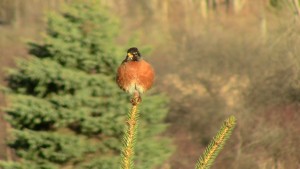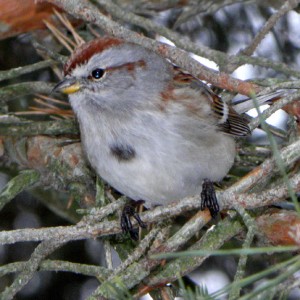A Birder’s Perspective
By Glen Wunderlich
Have you seen your first robin yet this year? I have.
I had just taken a break from chainsaw aerobics and had removed my safety helmet with hearing protection. When I first heard the cheerful tunes, I thought it sounded much like a robin but I was having trouble wrapping my mind around the notion that spring was here already. After all, it was January 21 and not an earthworm in sight.
Intently looking and listening, I heard the sound again. Sure enough, it was a robin alright. That’s when I caught its image atop a naked deciduous tree, just as the forlorned visitor flew off.
A few days later, while observing one of my feed sites, tiny juncos, chickadees, and titmice were dwarfed by another ground-feeding visitor: a wood thrush. They winter in lowland tropical forests in Central America but obviously, this loner didn’t get the memo.
A common sight on the ground is yet another visitor from the far north: the tree sparrow. Plump and long-tailed, American tree sparrows are busy visitors in winter backyards and weedy, snow-covered fields across southern Canada and the northern United States. Sometimes they number in the hundreds in a particular plot of indigenous pigweed I’ve left for their nourishment. In fact, it’s the primary reason I’ve quit trying to rid the patch of the otherwise undesirable weed.
Hopping up at bent weeds or even beating their wings to dislodge seeds from grass heads, they scratch and peck the ground in small flocks, trading soft, musical twitters. Come snowmelt, these small rusty-capped and smooth-breasted sparrows with a black spot on their breasts
begin their long migrations to breeding grounds in the tundra of the far North.
If you are fascinated by watching and studying birds, you may be interested in an online course at the Cornell Lab of Ornithology in Ithaca, N.Y. For the first time, lectures will be available online to anyone, anywhere.
Though species native to the Finger Lakes Region of New York will be discussed, course lectures are also packed with information about bird identification, migration, nesting, and other topics that are relevant to anyone hoping to improve their bird-watching skills.
The eight-week course is taking place March 23 through May 15. Visit birds.cornell.edu/sfo to learn about the course schedule, which will run concurrently with each Wednesday evening lecture available to online participants the following day. The online lectures will be hosted on the Cornell Lab’s Bird Academy website.
The course cost is $140 for online participants and is taught by Dr. Stephen Kress, Vice President for Bird Conservation for the National Audubon Society. “I can think of no better way to greet the spring migrants than taking part in Spring Field Ornithology,” says Kress. “Whether people take the course in person or watch the lectures online, they’ll come away knowing much more about birds and appreciate them so much more. There’s great value in that at a time when so many species are in trouble. Plus, bird watching is just great fun.”








